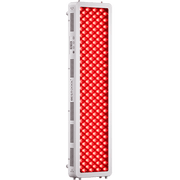Introduction
Did you know that around 300 million people practice yoga daily worldwide? More than 41 billion dollars are invested in pursuing strength and bliss on the yoga mat, and I'm right there with them. But for me, post-yoga muscle soreness was a real struggle. Sound familiar? 72% of us know that post-workout ache, right? But then, Red light therapy changed my life.
This wasn't some trendy studio-class thing. It was a red light therapy device in my living room, relaxing my tired muscles. I was skeptical at first, but with each session, the post-yoga soreness faded, replaced by a soothing sense of relaxation. I was tackling yoga poses I never thought I could. But it's not just about easing pain. Red light therapy turned my home yoga practice into a recovery session. I can exercise harder now without worrying about paying for it the next day. Today, we will explore how red light therapy can unlock the full potential of your yoga, one pain-free pose at a time.

Red Light Therapy Advantages for At-Home Yogis
Red light therapy is no longer a futuristic concept, instead, it's trending as an effective therapy among yogis who want to improve their practice and optimize their health. It stimulates cellular function, leading to numerous benefits that can enhance your yoga experience physically and spiritually.
Physical Benefits
- Enhanced Muscle Recovery
Red light therapy has the ability to increase blood flow and mitochondrial activity, thus leading to faster repair of muscle tissue after yoga sessions. This causes reduced soreness, faster recovery, and the ability to train harder and more frequently. Apart from this, research also demonstrated that red light therapy may decrease muscle damage and oxidative stress, both of which are barriers to muscle recovery.
- Improved Flexibility and Range of Motion
Increased collagen production and joint lubrication facilitated by red light therapy can enhance your flexibility and range of motion. This allows you to reach deeper into poses, improve your form, and experience greater freedom of movement on the mat. By reducing inflammation, red light therapy can help reduce stiffness in tendons, muscles, ligaments, and joints, thus improving the range of motion in the affected joints.
- Reduced Pain and Inflammation
Red light's anti-inflammatory properties can significantly reduce muscle and joint pain often associated with yoga practice. This allows you to push your limits without fear of discomfort, enhancing your enjoyment and progress. In a study (DB-RCT) of 80 chemotherapy patients, red light therapy showed a notable reduction in self-reported pain. Another research in which red light therapy was given with optimal doses of 904 nm and possibly 632 nm wavelengths directly to the lateral elbow tendon insertions seems to offer short-term pain relief and less disability.
- Increased Endurance
Red light therapy stimulates the production of adenosine triphosphate (ATP), the body's energy currency. This can boost your energy levels, improve stamina, and enhance your endurance during long yoga sessions. Stored ATP and your body's capacity to form ATP play a role in optimal muscle endurance. If you run out of ATP while practicing, your muscles lose their ability to contract effectively, causing fatigue. Red light therapy can improve mitochondrial function and ATP production to ensure more ATP is available for your muscle cells. A systematic review published in Lasers in Medical Science showed that RLT improves muscular performance and enhances recovery mainly when received before exercise. A study on exercise-trained mice concluded that light-emitting diode therapy increases ATP availability, which can delay the onset of fatigue and improve endurance performance.
- Improved Sleep Quality
Numerous research carried out on red light therapy indicate that it can regulate your circadian rhythm and< data-sanitized-data-mce-fragment="1" data-mce-fragment="1"> promote deeper, more restful sleep. This not only benefits overall recovery but also enhances your focus and energy levels on the mat. Studies have demonstrated that red light therapy helps in melatonin production. This can reset your "circadian clock" and increase the release of melatonin needed for healthy sleep.
Mental Benefits
- Reduced Anxiety and Depression
Are you experiencing any stress? Worry not! Various research on Red light therapy has shown that it can significantly reduce stress and anxiety, hence giving you relaxation, mindfulness, and focus.
- Mood Booster
Red light therapy can improve your mood. Isn't it amazing? Research has concluded that red light therapy can promote serotonin synthesis, which is an important neurotransmitter associated with feelings of joy and happiness. Research has also concluded that red light therapy increases your energy and improves moods by promoting self-confidence, positivity, joyfulness, and sensory stimulation.
- Enhanced Focus and Concentration
Do you find it challenging to remain focused on your goals? Red light therapy can improve Bain's cognitive function and concentration. So, you stay active during your practice and connect more deeply with yourself. A 2013 study by University of Texas researchers demonstrated that red light therapy improves mental health and is responsible for focused attention, impulse control, setting and achieving goals, and planning and coordinating sequences of actions.
- Relaxation and Mindfulness
Giving calming effects is another advantage of red light therapy. Thus, it can enhance your relaxation and mindfulness. Participants in one study on the effects of red light on depression and anxiety showed improvements in sleep and cognitive performance after receiving NIR light therapy.
Integrating Red Light Therapy Into Yoga Practice
Pre Yoga Preparation:
- Warm up muscles with simple moves like seated stretches or shoulder circles before yoga.
- Use red RLT for 5–10 minutes on these areas to prepare muscles for stretching and prevent injuries.
During Yoga
- Use a direct red light device on tight areas for 3-5 minutes during stretches to loosen up muscles and boost circulation.
- Take 2-3 minute breaks with a red light between challenging yoga moves to enhance relaxation.
Post Yoga Recovery
- After yoga, use RLT for 10–15 minutes on achy areas to reduce soreness and swelling.
- Use red light therapy for 10–20 minutes before bedtime for better sleep.

Conclusion
Get red light therapy sessions based on your needs and workout goals. Start with short sessions of around 5–10 minutes and gradually increase the time for long-term red light therapy benefits in your yoga routine.
References
- Schiffer, F., Johnston, A. L., Ravichandran, C., Polcarri, A., Teicher, M. H., Webb, R. H., & Hamblin, M. R. (2009). Psychological benefit of 2–4 weeks after a single treatment with near-infrared and red light to the forehead: a pilot study of 10 patients with major depression and anxiety. Behavioral and brain functions: BBF, 5, 46.
https://doi.org/10.1186/1744-9081-5-46
- Salehpour, F., Majdi, A., Pazhuhi, M., Ghasemi, F., Khademi, M., Pashazadeh, F., Hamblin, M. R., & Cassano, P. (2019). Transcranial Photobiomodulation Improves Cognitive Performance in Young Healthy Adults: A Systematic Review and Meta-Analysis. Photobiomodulation, Photomedicine, and Laser Surgery, 37(10), 635-643.
https://doi.org/10.1089/photob.2019.4673
- Caldieraro, M. A., & Cassano, P. (2018). Transcranial photo-biomodulation for major depressive and anxiety disorders and posttraumatic stress disorder. Photobiomodulation in the Brain, 479-487.
https://doi.org/10.1016/B978-0-12-815305-5.00035-X
- Zhao, J., Tinan, Y., Nie, J., Xu, J., & Liu, D. (2012). Red Light therapy and the Sleep Quality, Endurance Performance of Chinese Female Basketball Players. Journal of Athletic Training, 47(6), 673-678.
https://doi.org/10.4085/1062-6050-47.6.08
- Foster, R. E. (2020). Sleep, circadian rhythms and health. Interface Focus, 10(3). https://doi.org/10.1098/rsfs.2019.0098
Read More
- How Can Red Light Therapy Affects Your Sleep? – BESTQOOL
- The Benefits of Red Light Therapy – BESTQOOL
- Red Light Therapy Dosing Guide – BESTQOOL
- How To Create A Sleeping Routine For Newborns – BESTQOOL
- Engulfed in Light: Chromotherapy Sauna With Red Light Therapy – BESTQOOL














 Small
Small

 Moderate
Moderate

 Moderate
Moderate

 Moderate
Moderate

 Full
Full



